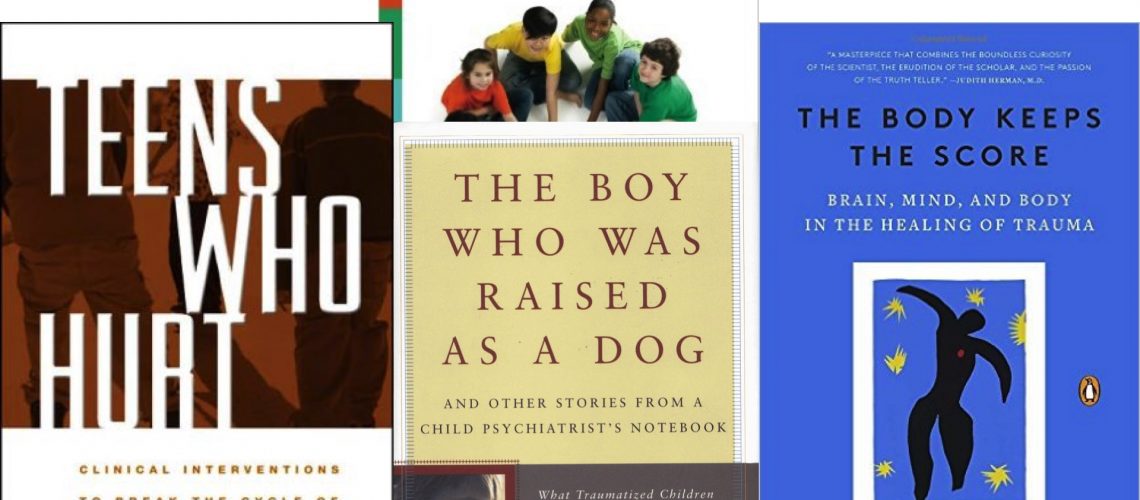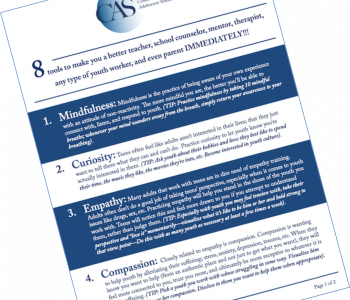

Sam Himelstein, PhD
Sam Himelstein is the founder and CEO of the Center for Adolescent Studies, Inc. He is passionate about working with youth and training the professionals that serve them.
4 “Must Read” Books for Professionals Working with Traumatized Youth
Becoming a Trauma-Informed Youth Professional takes commitment and dedication. As we prepare for the launch of the new online course Trauma-Informed Care for Professionals Working with Youth at CAS, I can’t help but reflect on some of the seminal teachings that have influenced my work; specifically the foundational texts I’ve read numerous times. To that end, below is a brief list of four books on trauma I think anyone working with youth should read. Three of the four books have specifically to do with youth, and although some are geared more toward education and others psychotherapy, the below list is a great starting point for folks interested in expanding their knowledge broadly across disciplines (in the future I’ll write posts on trauma books specifically geared toward therapists, educators, and so on).
So If you’re looking to deepen your knowledge about trauma in regard to working with youth, these are the four books I recommend you start with:
1) The Boy Who Was Raised As A Dog
Full Citation:
Perry, B., & Szalavitz, M. (2006) The boy who was raised as a dog: What traumatized children can teach us about love, loss, and healing. New York, NY: Basic Books.
Cost: $16.99 ($10.20 on Amazon)
Brief Summary:
The Boy Who Was Raised As A Dog is a critical read for anyone working with traumatized youth! Bruce Perry, developer of the Neurosequential Model and Senior Fellow at the Child Trauma Academy in Houston, Texas, writes both eloquently and informally while fully painting the picture of the devastating impact trauma has on children. The book has 11 chapters and each discusses a particular case, ranging from youth who’ve experienced extreme neglect and abuse, to youth who’ve been victims of being in cults and sexual abuse. What I find most helpful about this book is that it’s both easy to read and guides the reader to the depth of how each particular trauma has effected the youth in question. The authors do a great job of explaining the traumatic event, the symptoms that the youth present with, and therapeutic methods for engagement. This is a high recommend for all youth professionals but especially psychotherapists!
2) The Body Keeps The Score
Full Citation:
Van Der Kolk, B. (2014). The body keeps the score: Brain, mind, and body in the healing of trauma. New York, NY: Viking Penguin.
Cost: $27.95 Hardcover ($14.63 paperback on Amazon)
Brief Summary:
Plain and simple, Bessel Van der Kolk is probably one of the most influential trauma researchers of our generation. He founded the Trauma Center at the Justice Resource Institute and I’ve been to his workshops and read his books, and The Body Keeps the Score is one of the best resources a trauma therapist, teacher, or any type of youth professional working with traumatized teens can have. This is the only book on the list that isn’t specific to working with children and teens, however it made the list given its robust nature; Van der Kolk eloquently weaves together research, case examples, and easy to understand principles that will definitely enhance your knowledge on trauma. The book is split into four parts each 2-4 chapters (the exception being part 5 which has 8 chapters): 1) The rediscovery of trauma; where he contextualizes trauma socio-historically and discusses the revolution of neuroscience, 2) This is your brain on trauma; where he describes in easy to understand terms the effects of trauma on the brain, 3) The minds of children; in which early childhood trauma and the “hidden” epidemic of developmental trauma is skillfully reviewed, 4) The imprint of trauma; which covers in detail how traumatic memories impact those suffering from trauma, and 5) Paths to recovery, which overviews multiple treatment approaches. This book is a must have for anyone working with traumatized youth because it contextualizes how trauma arises and is held in the memory cells of the body and offers approaches to healing.
3) Supporting and Educating Traumatized Students
Full Citation:
Rossen, E., & Hull, R (Eds.) (2013). Supporting and educating traumatized students: A guide for school-based professionals. New York, NY: Oxford.
Cost: $61.00 ($57 on Amazon)
Brief Summary:
This is the only edited book on this list but it is an extremely useful resource! The book is categorized into three parts: 1) Introduction to trauma and its impact on school functioning; which includes chapters from Margaret Blaustein (who’s the director of training at the Trauma Center with Bessel Van der Kolk from the above book) and other experts in the field contextualizing specifically how trauma manifests in students and in school settings, 2) Potential sources of trauma and implications for classroom instruction and school-based interventions, which is probably the greatest resource in this book (at least in my opinion) and overviews multiple and diverse traumas (e.g., immigrant and homeless students, students exposed to community violence, students with parents who suffer from addiction and/or are incarcerated, and so on) and how to engage students struggling with such contexts, and 3) Administrative and policy considerations: Fostering resiliency, which includes chapters addressing school-wide implementations of trauma-informed policies and interventions. What I like most about this book is that you can simply pick it up and read the chapter that most suits your needs (e.g., Students from Military Families, by Courtney Carter) and get useful information that can be incorporated into your work immediately.
4) Teens Who Hurt
Full Citation:
Hardy, K., V. & Laszloffy, T. A. (2005). Teens who hurt: Clinical interventions to break the cycle of adolescent violence. New York, NY: Guilford.
Cost: $28.05 (from $19.22 used on Amazon)
Brief Summary:
Featuring one of the rock star authors of working with adolescents clinically (Dr. Kenneth Hardy), this book is on my top list for anyone who works with adolescents, period. No matter if you focus on teens struggling with trauma or not. The book tackles the issue of adolescent violence, but closely connects the causal or “aggravating,” as the authors state, factors that lead to teen violence and how to mitigate them. The book is simply broken down into two sections: 1) The Model, and 2) Strategies. In the first section a number of chapters discuss the aggravating factors of violence: devaluation, disruption of community, the dehumanization of loss, and rage. The second section discusses how to engage, heal, and transform each of the previous aggravating factors of teen violence. What I like most about this book is that it contextualizes trauma in the broader field of teen violence and discusses in detail factors that lead to violence. The authors discuss racism, oppression, and other forms of structural violence that have created communities in which gangs, drugs, and violence have thrived; which in turn lead to more traumatized teens. This book is a must read for professionals from ANY discipline working with teens!
—
As a reminder the above is simply a short list of the books I think are best to start reading for professionals working with youth and teens. Of course, there are many great books out there discussing trauma not specific to teens that are worth reading. The intention of this brief article is to aid in your reading list to help you become or continue to be a thriving trauma-informed youth professional.
Related Posts
3 Ways Compassion Can Help Youth Impacted by Trauma
The Four Essentials of Being a Trauma-Informed Youth Professional
4 “Must Read” Books for Professionals Working with Traumatized Youth
10 Essential Guidelines for Teaching Meditation to Trauma-Impacted Youth
To be part of a regular training community that offers FREE monthly live Trainings on Zoom, FREE courses on Trauma-Informed Care and discounts on paid courses for members, join our FREE Training Community, here.

